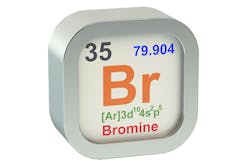Contaminant of the Month: Bromine and bromine disinfection
What is it?
- Bromine (Br) is the 35th element in the periodic table. Its atomic weight is 79.9 daltons. Elemental bromine exists as a diatomic form (Br2).
- Bromine is in the halogen family, below chlorine on the periodic table.
- It is a heavy red-brown, corrosive and reactive liquid.
- Its boiling point is 59oC (139oF), the melting point is -7.2oC (19) and its specific gravity is 3.119 grams per cubic centimeter (g/cm3).
- It is present in salt deposits as bromide (Br–), and some organobromine compounds are also found in nature.
- Seawater averages between 65 and 155 mg/L of bromide depending on location, equivalent to more than 100 trillion tons total. Chloride ranges from about 18,900 to 23,000 milligram/liter (mg/L).
- Microgram to milligram levels of bromide are commonly present in drinking water and foods.
Occurrence, production and uses
- Bromine is manufactured by the chlorine oxidation of bromide.
- Bromine is produced in several forms, including elemental bromine, bromine chloride (a mixed halogen product), hypobromous acid and bromochlorodimethylhydantoin.
- It has numerous applications in chemical syntheses, such as in the production of brominated flame retardants and fire extinguishing chemicals as well as some pharmaceuticals.
- It is an oxidant and disinfectant.
Disinfection applications
- Bromine hydrolyses in water to hypobromous acid (HOBr) and bromide.
- Bromine is an excellent primary disinfectant similar to chlorine, but with some advantages.
- It is used usually as bromochlorodime-thylhydantoin in swimming pools, spas and cooling towers.
- Some shipboard drinking water applications exist as a brominated resin, and in a pour-through point of use (POU) device as a brominated polymer.
- It is especially effective in the presence of ammonia such as sewage because its bromamines (NH2Br + NHBr2 + NBr3) and organic bromamines are much more potent disinfectants than the analogous chloramines.
- Bromamines’ disinfection efficacy is much greater than chloramines’ (combined chlorine) because their hydrolysis equilibrium in water favors hypobromous acid (HOBr), whereas chloramine hydrolysis produces only a small amount of hypochlorous acid (HOCl).
- Bromine is also more biocidal at higher pHs than chlorine because HOBr ionizes to a lesser degree than HOCl at pH 8.7.
- General relative disinfection potencies at equivalent doses are: HOCl ~ HOBr ~ NHxBry >> OCl– > OBr– >> NHxCly.
- Like chlorine, bromine will produce disinfection byproducts (DBPs) in water by reactions with the organic carbon precursors that are present.
Health effects
- Elemental bromine is acutely corrosive by dermal contact and inhalation.
- Bromide is relatively innocuous at typical exposures. It was once used as an over-the-counter sedative/depressant, but it is not currently. The chloride/bromide relationship in vivo is determined by relative dietary intake.
- Chlorine added to water containing
bromide produces hypobromous acid, which rapidly forms organobromine and mixed chloro/bromo compounds. The trihalomethanes include bromodichloromethane, dibrochloromethane, tribromomethane (bromoform) and chloroform. - Brominated DBPs are more biologically active in cellular test systems than their chlorinated counterparts. On the other hand, the four trihalomethanes have tested negative in modern cancer bioassay tests.
Water treatment technology
- Bromine compounds have numerous potential applications as disinfectants, especially in the presence of ammonia nitrogen.
- They are not widely used in wastewater applications because of higher unit costs and lack of familiarity. Their greater biocidal efficacy could offset the higher unit costs and is worthy of further evaluation.
- Drinking water applications are limited because of the formation of organobromine DBPs. However, a POU application exists that is designed to minimize DBP formation.
Regulation
Bromine is a registered disinfectant by the U.S. Environmental Protection Agency with drinking water applications aboard some navy ships and oil drilling platforms, as well as non-drinking water applications in swimming pools, spas and cooling towers. It is also registered for sanitizer uses. It is not used in public drinking water supply treatment.
Dr. Joe Cotruvo is president of Joseph Cotruvo and Associates, LLC, Water, Environment and Public Health Consultants. He is a former director of the EPA Drinking Water Standards Division.
